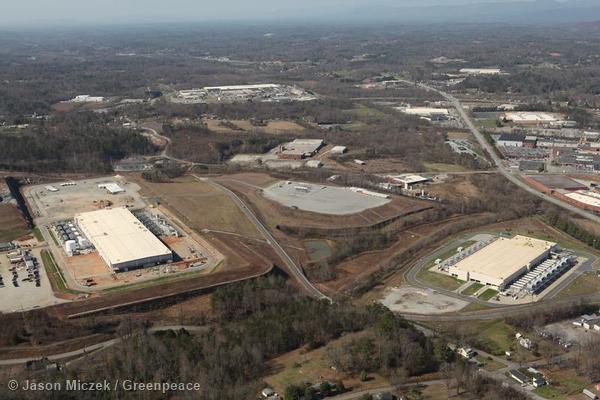It has been four years since Greenpeace first challenged IT companies to power their data centers with clean energy. Known collectively as the cloud, data centers host all of your photos, music, and email, plus the internet sites and apps we know and love.
Data centers use a tremendous amount of electricity, which is why Greenpeace has teamed up with internet users to ask companies to power our online lives with clean energy. With a greener online, we can have a greener offline too.
Were happy to report that many technology companies are using their trademark innovation to power their corners of the internet in increasingly green ways. Six internet leaders have committed to powering their operations with 100% clean energy. In the process, they are not only shifting the attitudes of their competitors, but the entire power sector as well.
Some companies have kept a blind eye to the green internet revolution. The most notable laggard is Amazon Web Services, whose cloud hosts popular internet services like Netflix and Pinterest. Twitter has also dragged their feet. Greenpeace will keep working with internet users and customers to get companies to realize that they should join the growing green internet bandwagon.
In the meantime, take a moment to celebrate these 9 green internet victories, made possible by supporters like you.
September, 2011: Google increases transparency on its data center energy use Five months after Greenpeace published its first report scoring companies and their data centers, Google releases information on exactly how much energy it takes to provide searches, email, YouTube videos and all other Google services, as well as its energy mix. Until then, tech companies had refused to release such information, saying it would place them at a competitive disadvantage. Googles move shifted that paradigm and set a new bar in the industry for openness and transparency one thats since been raised even higher by its peers.
December, 2011: Facebook commits to 100% renewable energy After a 20-month Greenpeace campaign calling on Facebook to Unfriend Coal, Facebook commits to a goal of powering its data centers with 100% renewable energy.
May, 2012: Apple commits to 100% renewable energy for its iCloud Apple announces a doubling of its solar installations at its North Carolina data center, along with a commitment that all of its data centers will be powered by 100% renewable energy. After hearing from its customers that they wanted a clean iCloud, Apple responded in a big way, and has since become one of the sectors most impressive leaders in building a green internet.
June, 2012: eBay quits the coal grid for its Utah data center eBay installs fuel cells for its Utah data center, setting them up in a way that allows the facility to run independently from the local electricity grid, which is heavily powered by coal. eBay is allowed to install the fuel cells only after lobbying the state government for changes in the law. While fuel cells are not renewable energy, they did help eBay reduce its use of coal, and the companys advocacy shows how IT companies can kickstart a cleaner energy mix.
April, 2013: Apple, Facebook, Google team up to push nations largest utility to renewable energy offering Apple, Facebook and Google team up to compel their utility in North Carolina, Duke Energy, to offer a breakthrough renewable energy program. Under the Green Source Rider, Duke will offer its biggest customers renewable power options for the first time. Duke is one of the nations largest carbon emitters, relying on large amounts of coal, gas and nuclear power. And while its Green Source Rider is far from perfect, it proves the power that IT companies have to compel utilities to start to change.
July, 2013: Apple chooses solar for Nevada data center Apple announces it will work with local utility NV Energy to power its data center near Reno, NV with 100% solar and geothermal power. The announcement follows Apples commitment from the previous year to power 100% of its cloud with renewable energy. The solar portion of the facility will use mirrors to concentrate sunlight up to seven times onto photovoltaic cells.

A Greenpeace activist in an Apple iPhone costume hands a leaflet to an Apple employee arriving for work at company headquarters. Apple is one of a handful of companies leading the charge toward a green internet.
September, 2013: Google’s new wind power deal shows real corporate leadership Google announces that it is purchasing 48 megawatts of wind power for its data center in Oklahoma, USA enough clean energy to power a small city. The move is another example of how big IT companies can change the power source mix around them.
November, 2013: Box, Rackspace and Salesforce committed to 100% renewable energy Box becomes the sixth company to join the club of IT firms which have committed to powering their cloud with 100% renewable energy. By this point Google, Facebook, Apple, Salesforce and Rackspace have also committed.
November, 2013: Facebook powers new Iowa data center with 100% wind energy Facebook announces that it will use 100% wind energy to power its data center in Iowa. The move pushes local utility MidAmerican Energy to cancel a planned nuclear plant in favor of the wind power Facebook wants.




